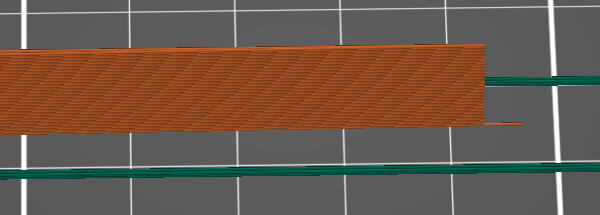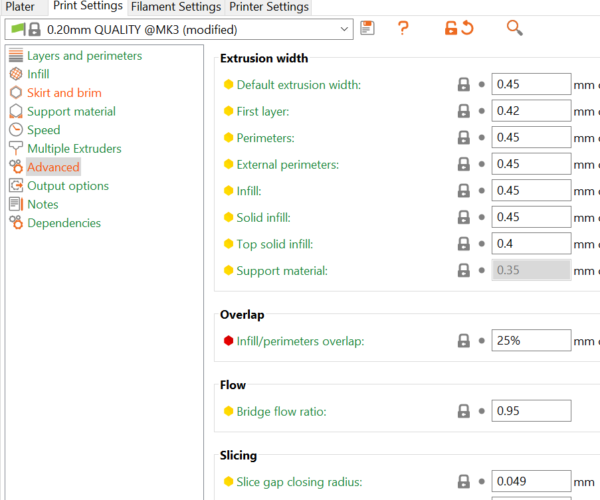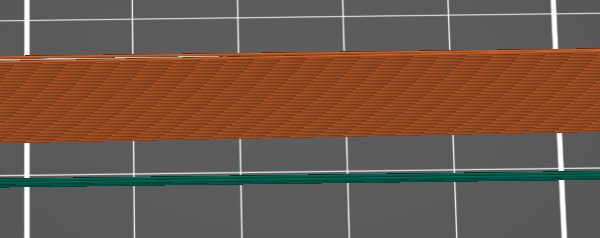Extrusion Problems with 0.25 Nozzle
Hey guys,
We just switched to an E3D 0.25mm nozzle a couple of days ago, we have only used 0.40 for 2.5 years we have the printer. We are also using Esun PLA+. But with the 0.25 nozzle, the layers are not bonding correctly and the extrusion stops mid-print. We raised the extruder temperature to 225-230 and got some good results, however when we switched to an older Esun filament (yellow in particular), the first print the first layer was there, after the first layer the extrusion stops and it gets all stringy on the print.
We changed the filament again to a different Esun color, now it is not even printing the first layer. I think we broke something 😀
On the slicer max print speed is 70mm/s and the max volumetric speed is 11.5 if it is the case. Retraction is 0.8mm (default prusa profile settings for 0.25mm nozzle.
What I'm thinking is maybe the nozzle is clogged. Should we do a cold pull? The thing is, when we load the filament it gets out of the nozzle without any problem, when printing there is no filament.
Any help would be appreciated, thanks!
Try slowing down
A cold pull never hurts, but if filament extrudes well, it doesn't sound like a clog.
A 0.25mm nozzle produces much more back pressure in the hotend. This means your effective flow rate (MVS) will be lower than with a larger nozzle. IME, 70mm/s is way too fast for 0.25mm.
A quick test is to dial speeds way back mid print using the front knob. Set the rate to 50% or lower. If it prints at lower speeds, you have your answer.
A 0.25mm nozzle is good for fine detail prints, not speed. If you want faster prints, stick with a larger nozzle.
If you want to see what a safe MVS setting for your 0.25mm nozzle, I have notes on how to test here.
and miscellaneous other tech projects
He is intelligent, but not experienced. His pattern indicates two dimensional thinking. -- Spock in Star Trek: The Wrath of Khan
.25 nozzle and layer height.
.25 will have trouble with low layer heights in particular - recommend avoiding .1 and .15 mm layer height with that tiny nozzle. You'll need to tell your slicer you changed the nozzle as well so that it is not trying to feed .4 worth of filament through the .25 nozzle.
Were you going for detail and switched to .25 and using small layer heights for more detail? I'd recommend not going below .2mm height. If you want super detail, you should consider SLS
Thanks
Thank you for the reply. So if I'm getting this right, when I'm printing with 0.15 layer height and 0.25mm extrusion width, the speed should be around 30mm/s to achieve roughly 1.125 MVS. My setting was way too fast that's for sure.
We switched to a smaller nozzle because we want to print and sell clay cutters with sharp edges (0.40mm on the cutting edge) and could not manage to get it to slice to print it with 0.40mm extrusion width with 0.40mm nozzle. The slicer just skips the upper cutting edge.
If we check "detect thin walls", it makes the slicing and print, however, there are some open seams and even holes on the thin parts. (Photo attached)
https://drive.google.com/file/d/1AbwBwLaiJyjxMWKuANtcR0GVzK3IBbKK/view?usp=sharing
https://drive.google.com/file/d/1zYv1d0wNb8zCstMD0CDJRjXbjhywWyCY/view?usp=sharing
Here is the comparison, the left one was printed with a 0.40mm nozzle (the cutting edge is 0.5mm with a single wall) the right one was printed with 0.25mm. https://drive.google.com/file/d/1dVKM5x2D6D0Xw-XiT8dHEt3zyHZEnOx1/view?usp=sharing
It would be perfect if we can produce clean prints with 0.40mm nozzle as it should be capable.
Slow and steady with smaller nozzles, maybe try an intermediate nozzle size or tweak design parameters
Thank you for the reply. So if I'm getting this right, when I'm printing with 0.15 layer height and 0.25mm extrusion width, the speed should be around 30mm/s to achieve roughly 1.125 MVS. My setting was way too fast that's for sure.
I'm not sure what your MVS should be -- I have only tested with 0.4mm nozzles and up -- but the "red line" MVS for some PLA through a 0.4mm nozzle was well below 6.5mm^3/s. That's the point at which you start to see extruder skips, bucking, clicking, and jams. I'll try to add some tests with smaller nozzles.
I'd try cranking MVS way back like you have until you get good results, then slowly increment it and see where a good practical maximum is. I found 50% of the maximum (as tested above) is usually safe. If you're printing slowly, MVS may never be an issue.
We switched to a smaller nozzle because we want to print and sell clay cutters with sharp edges (0.40mm on the cutting edge) and could not manage to get it to slice to print it with 0.40mm extrusion width with 0.40mm nozzle. The slicer just skips the upper cutting edge.
If we check "detect thin walls", it makes the slicing and print, however, there are some open seams and even holes on the thin parts. (Photo attached)
Thin wall detection is definitely a mixed blessing. You can also find 0.3 and 0.35mm nozzles that might be a better middle ground. I like the P3-D Apollo coated nozzles myself.
[...] It would be perfect if we can produce clean prints with 0.40mm nozzle as it should be capable.
Does using a 0.45mm cutting edge on the cutters make much of a difference? If you have designed the cutters, you can exactly match your slicer settings and you should get a good, strong result.
and miscellaneous other tech projects
He is intelligent, but not experienced. His pattern indicates two dimensional thinking. -- Spock in Star Trek: The Wrath of Khan
Your 0.4mm result looks pretty good in the side-by-side comparison
[...] Here is the comparison, the left one was printed with a 0.40mm nozzle (the cutting edge is 0.5mm with a single wall) the right one was printed with 0.25mm. [...] It would be perfect if we can produce clean prints with 0.40mm nozzle as it should be capable.
That print on the left can be cleaned up. If the cutting edge was adequate for your purposes, again try just slowing the print down and see what impact that has on overall quality. Start slow until you get good quality, then gradually crank up speeds to see if and how you can optimize production.
You might try using a bevel/chamfer from the thicker wall to the thinner cutting edge to give the cutter more durability and stability. You want it thin for cutting, but the rest of the blade can be thicker.
and miscellaneous other tech projects
He is intelligent, but not experienced. His pattern indicates two dimensional thinking. -- Spock in Star Trek: The Wrath of Khan
RE: possibilities
typically a 0.4mm nozzle prints with a wider extrusion width, if the model width of a feature is smaller than the extrusion width the slicer will normally ignore it.
below is an image of a tapered part, in Prusa Slicer. the taper reduces from 1.0mm at the left hand post to 0.2mm at the right hand post
when sliced, you can see that the taper is only partially rendered by the slicer.
you can see where the lower edge is rendered slightly further because the bottom layer extrusion width is 0.42mm whilst the higher layers are 0.45 extrusion width.
if you adjust the XY Compensation value from 0mm to 0.1mm in the Print Settings Advanced menu, 
and then re slice the model, you will see that the model will slice further, because the walls are artificially thickened by the XY compensation option
in the case of this model this almost completes the wall to the second pin.
If you increase the XY Compensation value to 0.125mm, then the wall completes all of the way to the right hand pin.
I enclose a project file for you to play with
Taper test
If you download this file, then unzip it, the resulting .3mf file should open in Prusa Slicer, with the model on the platter and XY compensation set to 0mm. you can slice the model, and see what happens, then increase the XY Compensation a little at a time, re slicing to see the effect.
In your case, if the edge is modelled at 0.4mm thick, then increasing the XY compensation to 0.026, should allow the cutting edge to slice properly.
regards Joan
I try to make safe suggestions,You should understand the context and ensure you are happy that they are safe before attempting to apply my suggestions, what you do, is YOUR responsibility.Location Halifax UK
Thank you all
I've read all your replies and decided to print a 0.40mm wall thickness cutter model with the 0.40mm nozzle, with the detect thin walls "On", the result was OK, but there are some under extrusions in random places. I'm sure they are not "layer start or end locations", as I've changed the seam position to Aligned when creating the Gcode.
https://drive.google.com/file/d/1mkD4hqnzQpPW6z7P6mwa5JZijVdnTVMm/view?usp=sharing
I'm printing with 215/60 on the first layer and 230/60 on the rest. Maybe it is again a speed issue because we are used to printing large objects like pet food bowls before on the standard setup in the PrusaSlicer (0.20mm Quality) and never really struggled with smaller prints. The settings were like this when printing the cutter, and around the last section of the model I've changed the speed around 80% with the knob: https://drive.google.com/file/d/1-EtHxq09RIbM9rY9mEyAesMEscg-MJrx/view?usp=sharing
The reason behind the 230 degrees is that there were some blobs on the layer start positions, so in order to remove them we upped the temperature, these blobs are something we want to avoid as it leaves a mark when cutting clay.
By the way, this is the second printer, never changed the original 0.40mm nozzle in 2.5 years, never applied cold pull. Maybe it needs some cleaning, I'm out of opinions.
How many slices does a clay cutter last till the edge is worn out?
I just printed a thing with very sharp edges. Maybe you should start there. The print is that orgami hanging swan - it's in the print library. It prints very thin edges. There will be warts and such - but heck a hand file eliminates pretty much all imperfections on the edge and I can get it so fine it will cut paper. But it's plastic - how long do you expect the clay knife to hold an edge? A file is faster than reprinting another one - just lap the edge back sharp at the end application.
marks in the clay? Try a file.